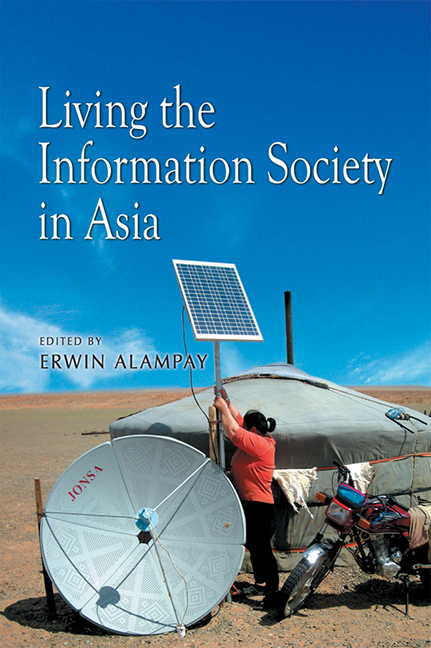Book contents
- Frontmatter
- Contents
- Foreword
- Preface
- List of Abbreviations
- Contributors
- Introduction: Perspectives of ICT Research in Asia
- 1 What Would Durkheim Have Thought? Living in (and with) the Information Society
- 2 What Is a Mobile Phone Relationship?
- 3 Technologies of Transformation: The End of the Social or the Birth of the Cyber Network?
- 4 Becoming Mobile in Contemporary Urban China: How Increasing ICT Usage Is Reformulating the Spatial Dimension of Sociability
- 5 Mobile Religiosity in Indonesia: Mobilized Islam, Islamized Mobility and the Potential of Islamic Techno Nationalism
- 6 Moral Panics and Mobile Phones: The Cultural Politics of New Media Modernity in India
- 7 Stories from e-Bario
- 8 Life and Death in the Chinese Informational City: The Challenges of Working-Class ICTs and the Information Have-less
- 9 Institutional Responses to GIS Adoption for RPTA in Local Governments
- 10 Customer Acquisition among Small and Informal Businesses in Urban India: Comparing Face-to-Face and Mediated Channels
- 11 The View from the Other Side: The Impact of Business Process Outsourcing on the Well-being and Identity of Filipino Call Centre Workers
- 12 Empowering Thai Homeworkers through ICTs
- Index
10 - Customer Acquisition among Small and Informal Businesses in Urban India: Comparing Face-to-Face and Mediated Channels
Published online by Cambridge University Press: 21 October 2015
- Frontmatter
- Contents
- Foreword
- Preface
- List of Abbreviations
- Contributors
- Introduction: Perspectives of ICT Research in Asia
- 1 What Would Durkheim Have Thought? Living in (and with) the Information Society
- 2 What Is a Mobile Phone Relationship?
- 3 Technologies of Transformation: The End of the Social or the Birth of the Cyber Network?
- 4 Becoming Mobile in Contemporary Urban China: How Increasing ICT Usage Is Reformulating the Spatial Dimension of Sociability
- 5 Mobile Religiosity in Indonesia: Mobilized Islam, Islamized Mobility and the Potential of Islamic Techno Nationalism
- 6 Moral Panics and Mobile Phones: The Cultural Politics of New Media Modernity in India
- 7 Stories from e-Bario
- 8 Life and Death in the Chinese Informational City: The Challenges of Working-Class ICTs and the Information Have-less
- 9 Institutional Responses to GIS Adoption for RPTA in Local Governments
- 10 Customer Acquisition among Small and Informal Businesses in Urban India: Comparing Face-to-Face and Mediated Channels
- 11 The View from the Other Side: The Impact of Business Process Outsourcing on the Well-being and Identity of Filipino Call Centre Workers
- 12 Empowering Thai Homeworkers through ICTs
- Index
Summary
OVERVIEW
In both the popular press and the academic/development literatures, there is much enthusiasm about the potential of information and communication technologies (ICTs) to improve the productivity of small and informal businesses in the developing world. Clearly, ICTs can help small businesses replace travel and save money, compare price information, respond to existing customers, and find new customers (Saunders et al. 1994). As more small businesses gain access to ICTs, the research community is working to provide a more detailed understanding of the magnitude and details of these improvements. This study contributes to this effort by focusing on the role of ICTs in customer acquisition and retention by the smallest of enterprises. To do so, it surveys 317 sole proprietors and operators of small businesses with five or fewer employees in and around urban Hyderabad in Southern India.
The mobile telephone has become the ICT most useful to small and informal businesses as a means for developing and maintaining contacts with customers (Donner 2006; Esselaar et al. 2006; Vodafone 2005). However, we know relatively little about the relative importance of mediated versus face-to-face means of customer interaction. Molony's (2006) ethnographic work in Tanzania suggests that the trust accrued through face-to-face interactions trumps the convenience of any telephone, but additional quantitative work is necessary to further this line of inquiry, and to bring it into other developing-world contexts.
In this survey, respondents were asked to report how various customers were acquired — via walk-in, referral, landline telephone, mobile phone, internet/email, etc. The results are presented and discussed in two parts. The first is descriptive, focusing on the aggregated responses from the 317 small businesses. These responses suggest that face-to-face interactions dominate customer interactions, even among those with access to ICTs.
The second part tests four hypotheses about the role of landline and mobile telephones in shaping the business networks of small businesses. Four tests explore whether telephony enables more specialized, handsoff, numerous or distant relationships with customers; only a significant relationship between landline ownership and total number of customers is found.
BACKGROUND
The term “small and informal business” refers to a broad range of enterprises in the developing world. The most numerous of these enterprises are sole proprietorships, often home-based, temporary, or part-time. Beyond the sole proprietor, the boundaries of the small and informal enterprise space are blurry.
- Type
- Chapter
- Information
- Living the Information Society in Asia , pp. 186 - 208Publisher: ISEAS–Yusof Ishak InstitutePrint publication year: 2009

